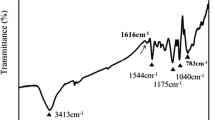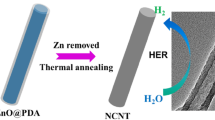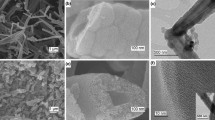Abstract
Fabricating nitrogen-doped carbon layers over the conductive substrate is a cost-effective and efficient approach to develop practical oxygen reduction reaction (ORR) catalyst. In the current work, relying on the commercially available carbon nanotube (CNT), nitrogen-doped carbon layers over CNT is constructed by annealing the in situ formed complex over the CNT surface derived from iron ion inducing diaminonaphthalene (DAN) polymerization and DAN self-polymerization. Physical and electrochemical characterizations are carefully conducted to comparatively analyze the structure and activity relationship. The significance of iron in constructing nitrogen-doped carbon layers and tuning active sites of N types over multiwall carbon nanotube for ORR is demonstrated by X-ray photoelectron spectroscopy and Raman scattering spectrum. The excellent performance of nitrogen-doped carbon layers over CNT (catalyzed by iron) towards ORR is displayed by rotating ring-disk electrode. Specifically, the onset potential, half-wave potential, and limiting current density are 0.961 V, 0.831 V, and 5.20 mA cm−2 respectively, very close to the state-of-the-art commercial Pt/C catalyst. Both high surface area and efficient N active sites should be considered in the nitrogen-doped carbon materials design and fabrication for ORR. Considering the large-scale availability, it has significant value in fuel cells commercial applications.




Similar content being viewed by others
References
Feng L, Xue H (2017) Advances in transition-metal phosphide applications in electrochemical energy storage and catalysis. ChemElectroChem 4(1):20–34
Borghei M, Lehtonen J, Liu L, Rojas OJ (2017) Advanced biomass-derived electrocatalysts for the oxygen reduction reaction. Adv Mater 30:1703691
Zhang L, Wilkinson DP, Liu Y, Zhang J (2018) Progress in nanostructured (Fe or Co)/N/C non-noble metal electrocatalysts for fuel cell oxygen reduction reaction. Electrochim Acta 262:326–336
Wang F, Xue H, Tian Z, Xing W, Feng L (2018) Fe2P as a novel efficient catalyst promoter in Pd/C system for formic acid electro-oxidation in fuel cells reaction. J Power Sources 375:37–42
Zamburlini E, Jensen KD, Stephens IEL, Chorkendorff I, Escudero-Escribano M (2017) Benchmarking Pt and Pt-lanthanide sputtered thin films for oxygen electroreduction: fabrication and rotating disk electrode measurements. Electrochim Acta 247:708–721
Qian Y, Du P, Wu P, Cai C, Gervasio DF (2016) Chemical nature of catalytic active sites for the oxygen reduction reaction on nitrogen-doped carbon-supported non-noble metal catalysts. J Phys Chem C 120(18):9884–9896
Mamtani K, Jain D, Zemlyanov D, Celik G, Luthman J, Renkes G, Co AC, Ozkan US (2016) Probing the oxygen reduction reaction active sites over nitrogen-doped carbon nanostructures (CNx) in acidic media using phosphate anion. ACS Catal 6(10):7249–7259
Wang L, Ambrosi A, Pumera M (2013) “Metal-free” catalytic oxygen reduction reaction on heteroatom-doped graphene is caused by trace metal impurities. Angew Chem Int Ed 52(51):13818–13821
Liu X, Dai L (2016) Carbon-based metal-free catalysts. Nat Rev Mater 1(11):16064
Deng H, Li Q, Liu J, Wang F (2017) Active sites for oxygen reduction reaction on nitrogen-doped carbon nanotubes derived from polyaniline. Carbon 112:219–229
Liu J, Song P, Xu W (2017) Structure-activity relationship of doped-nitrogen (N)-based metal-free active sites on carbon for oxygen reduction reaction. Carbon 115:763–772
Zhang L, Xia Z (2011) Mechanisms of oxygen reduction reaction on nitrogen-doped graphene for fuel cells. J Phys Chem C 115(22):11170–11176
Zhang J, Xia Z, Dai L (2015) Carbon-based electrocatalysts for advanced energy conversion and storage. Sci Adv 1(7):e1500564
Wang B, Tsetseris L, Pantelides ST (2013) Introduction of nitrogen with controllable configuration into graphene via vacancies and edges. J Mater Chem A 1(47):14927–14934
Osmieri L, Monteverde Videla AHA, Specchia S (2015) Activity of Co–N multi walled carbon nanotubes electrocatalysts for oxygen reduction reaction in acid conditions. J Power Sources 278:296–307
Chun K-Y, Lee HS, Lee CJ (2009) Nitrogen doping effects on the structure behavior and the field emission performance of double-walled carbon nanotubes. Carbon 47(1):169–177
Li H, Huang Y, Zhou H, Yang W, Li M, Huang Z, Fu C, Kuang Y (2017) One step in-situ synthesis of Co@N, S co-doped CNTs composite with excellent HER and ORR bi-functional electrocatalytic performances. Electrochim Acta 247:736–744
Kim S, Jang D, Lim J, Oh J, Kim SO, Park S (2017) Cobalt-based active species molecularly immobilized on carbon nanotubes for the oxygen reduction reaction. ChemSusChem 10(17):3473–3481
Ning R, Ge C, Liu Q, Tian J, Asiri AM, Alamry KA, Li CM, Sun X (2014) Hierarchically porous N-doped carbon nanoflakes: large-scale facile synthesis and application as an oxygen reduction reaction electrocatalyst with high activity. Carbon 78:60–69
Wang S, Yu D, Dai L, Chang DW, Baek J-B (2011) Polyelectrolyte-functionalized graphene as metal-free electrocatalysts for oxygen reduction. ACS Nano 5(8):6202–6209
Malko D, Lopes T, Symianakis E, Kucernak AR (2016) The intriguing poison tolerance of non-precious metal oxygen reduction reaction (ORR) catalysts. J Mater Chem A 4(1):142–152
Wang F, Yang X, Dong B, Yu X, Xue H, Feng L (2018) A FeP powder electrocatalyst for the hydrogen evolution reaction. Electrochem Commun 92:33–38
Zhao P, Xu W, Hua X, Luo W, Chen S, Cheng G (2016) Facile synthesis of a N-doped Fe3C@CNT/porous carbon hybrid for an advanced oxygen reduction and water oxidation electrocatalyst. J Phys Chem C 120(20):11006–11013
Li M, Wang W, Yang M, Lv F, Cao L, Tang Y, Sun R, Lu Z (2015) Large-scale fabrication of porous carbon-decorated iron oxide microcuboids from Fe-MOF as high-performance anode materials for lithium-ion batteries. RSC Adv 5(10):7356–7362
Zhang Y, Sun Z, Wang H, Wang Y, Liang M, Xue S (2015) Nitrogen-doped graphene as a cathode material for dye-sensitized solar cells: effects of hydrothermal reaction and annealing on electrocatalytic performance. RSC Adv 5(14):10430–10439
Li J, Zhang Y, Zhang X, Han J, Wang Y, Gu L, Zhang Z, Wang X, Jian J, Xu P, Song B (2015) Direct transformation from graphitic C3N4 to nitrogen-doped graphene: an efficient metal-free electrocatalyst for oxygen reduction reaction. ACS Appl Mater Interfaces 7(35):19626–19634
Liu Q, Duan Y, Zhao Q, Pan F, Zhang B, Zhang J (2014) Direct synthesis of nitrogen-doped carbon nanosheets with high surface area and excellent oxygen reduction performance. Langmuir 30(27):8238–8245
Li J-C, Zhao S-Y, Hou P-X, Fang R-P, Liu C, Liang J, Luan J, Shan XY, Cheng HM (2015) A nitrogen-doped mesoporous carbon containing an embedded network of carbon nanotubes as a highly efficient catalyst for the oxygen reduction reaction. Nanoscale 7(45):19201–19206
Li X-F, Lian K-Y, Liu L, Wu Y, Qiu Q, Jiang J, Deng M, Luo Y (2016) Unraveling the formation mechanism of graphitic nitrogen-doping in thermally treated graphene with ammonia. Sci Rep 6(1):23495
Wang Y, Chen W, Nie Y, Peng L, Ding W, Chen S, Li L, Wei Z (2017) Construction of a porous nitrogen-doped carbon nanotube with open-ended channels to effectively utilize the active sites for excellent oxygen reduction reaction activity. Chem Commun 53(83):11426–11429
Acknowledgements
We acknowledge the technical support received at the Testing Center of Yangzhou University.
Funding
The work is supported by the National Natural Science Foundation of China (21603041), a project funded by the Priority Academic Program Development of Jiangsu Higher Education Institution.
Author information
Authors and Affiliations
Corresponding author
Ethics declarations
Conflict of interest
The authors declare no conflict of interest.
Electronic supplementary material
ESM 1
(DOCX 935 kb)
Rights and permissions
About this article
Cite this article
Liu, Z., Wang, Y. & Feng, L. A facile approach for constructing nitrogen-doped carbon layers over carbon nanotube surface for oxygen reduction reaction. J Solid State Electrochem 22, 3467–3474 (2018). https://doi.org/10.1007/s10008-018-4061-5
Received:
Revised:
Accepted:
Published:
Issue Date:
DOI: https://doi.org/10.1007/s10008-018-4061-5




